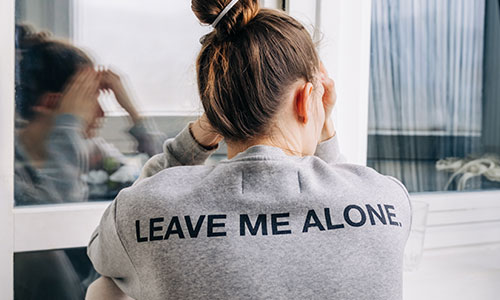6 Qualities in a Partner That Provide the Best Chance of a Healthy Relationship
18th December 2020
As much as the use of attachment styles may inadvertently place us within a very closed definition that can limit growth, they still remain a useful model for understanding the intricacies of behaviour that can impact our connection with others. Fearful avoidant attachment is an often misunderstood attachment style that can significantly impact an individual’s capacity to feel safe and secure in relationships. This can lead to difficulty forming and maintaining secure and fulfilling connections.
What is a Fearful-Avoidant Attachment Style?
Sometimes referred to as disorganised attachment, fearful avoidance is one of the four primary attachment styles characterised by a high level of anxiety and avoidance. Individuals with this attachment style typically grapple with emotional dysregulation and intimacy issues, stemming from a complex interplay of factors.
The core symptom set of fearful-avoidance is a combination of anxiety and avoidance. The anxiousness of the fearful-avoidant relates to the individual’s heightened sensitivity to rejection and abandonment, resulting in a constant state of worry and vigilance in relationships. The avoidance component, on the other hand, encompasses the individual’s tendency to maintain emotional distance and resist intimacy, driven by a deep-seated fear of vulnerability.
Disorganised Attachment Causes: Exploring the Origins
While it often begins in childhood due to traumatic experiences, there are various scenarios and situations that can contribute to the development of fearful avoidance. The role primary caregivers have in shaping attachment styles can’t be overstated, as they provide the foundation for a child’s understanding of love and connection. And so, caregivers who are inconsistent or fail to provide a safe and nurturing environment may inadvertently foster the development of an insecure attachment style such as fearful-avoidant.
Specific situations that can contribute to this attachment style include:
Emotional neglect: Caregivers may be physically present but emotionally unavailable, causing the child to feel unsupported and confused about their emotional needs.
Physical or emotional abuse: Experiencing abuse from a caregiver or witnessing abuse between caregivers can create a sense of insecurity, causing the child to be fearful of emotional closeness as a result of their trust issues.
Loss or abandonment: Experiencing the loss of a caregiver through death or separation can result in the child developing a fear of abandonment, leading to a reluctance to form close connections in adulthood.
Parental inconsistency: When caregivers alternate between providing warmth and affection and displaying cold, distant, or punitive behaviour, the child may struggle to develop a consistent sense of security.
Parental mental health issues: Caregivers with their own unresolved trauma or mental health issues may have difficulty providing the emotional stability and support necessary for the child to develop a secure attachment.
Chaotic home environments: Living in an unpredictable and chaotic home environment can make it difficult for the child to establish a sense of safety and security, leading to the development of a fearful-avoidant attachment style.
Disorganised Attachment in Adults: Recognising the Signs and Signals
Here are some common signs of fearful-avoidant attachment in adults, along with a brief description of what they might look like:
Inconsistency in relationships: Fearful-avoidant individuals may experience fluctuating emotions in their relationships, often oscillating between wanting closeness and pushing their partner away. They might seem warm and loving one moment, and distant or cold the next.
Heightened sensitivity to attachment triggers: These individuals are more likely to react strongly to perceived threats in their relationships, such as criticism or perceived abandonment. This can lead to frequent misunderstandings and conflicts with partners.
Emotional distancing: Fearful-avoidant individuals might withdraw emotionally from their partners when they feel threatened, as a way to protect themselves from potential rejection or abandonment. This distancing can manifest as evasive behaviour, avoiding difficult conversations, or even sabotaging the relationship.
Dependency: On the other hand, they might become overly dependent on their partner, seeking constant reassurance and validation to alleviate their insecurities. This can be emotionally draining for both partners and often leads to further dysfunction.
Difficulty trusting others: Due to their past experiences, fearful-avoidant individuals often struggle to trust their partners and may be suspicious of their motives, leading to jealousy or controlling behaviour.
Poor emotional regulation: These individuals may have difficulty managing their emotions, leading to mood swings, intense emotional reactions, or even outbursts during stressful situations. Fear of commitment: Fearful-avoidant individuals may be hesitant to commit fully to a relationship, fearing that they will be hurt or abandoned. They might avoid discussing the future, resist making long-term plans, or struggle to express their feelings openly.
How Fearful-Avoidant Attachment Influences Relationships
Here ’s what some of these signs look like in the context of a relationship.
Example: Inconsistency in relationships
Why it’s harmful: This inconsistency can be confusing and hurtful for the partner of the fearful-avoidant, who may feel unsure of where they stand in the relationship. It can lead to a lack of emotional security, causing a sense of unease in both individuals.
Tools and Strategies: Open communication is key to addressing this issue. This requires both partners having the willingness to discuss their feelings and concerns with one another, working together to create a more stable and secure emotional environment. Fearful-avoidant individuals can also benefit from therapy or counselling to understand the root causes of their inconsistency and develop healthier attachment patterns.
Example: Heightened sensitivity to attachment triggers
Why it’s harmful: This heightened sensitivity can lead to frequent misunderstandings and conflicts, creating a tense and unstable relationship dynamic. It may also cause the supporting partner to feel like they’re walking on eggshells, as they try to avoid triggering the fearful-avoidant person’s insecurities.
Tools and Strategies: Developing self-awareness and emotional regulation skills can help the fearful-avoidant individual better manage their reactions to triggers. Couples can also work together to identify and address these triggers, fostering a more secure and understanding relationship.
Example: Emotional distancing
Why it’s harmful: Emotional distancing can lead to feelings of loneliness and disconnection in the relationship, making it difficult for both partners to feel truly close and supported.
Tools and Strategies: Fearful-avoidant individuals can work on developing emotional awareness and expressing their feelings more openly. Couples can also engage in activities that foster emotional intimacy, such as deep conversations, shared experiences, or affectionate touch.
Example: Dependency
Why it’s harmful: Over-dependency can be emotionally draining for both partners and may lead to an unhealthy dynamic where one person feels responsible for the other’s emotional well-being.
Tools and Strategies: Building a strong sense of self and practising self-reliance can help fearful-avoidant individuals become less dependent on their partners. They can also work on developing healthy communication patterns and expressing their needs without overburdening their partner.
Example: Difficulty trusting others
Why it’s harmful: This lack of trust can lead to jealousy, controlling behaviour, and constant suspicion, which can erode the foundation of a healthy relationship.
Tools and Strategies: Fearful-avoidant individuals can benefit from therapy or counselling to address their trust issues and work on developing healthier thought patterns. Couples can also practice transparency and open communication to build trust over time.
Example: Poor emotional regulation
Why it’s harmful: Poor emotional regulation can create a volatile relationship environment, making it difficult for both partners to feel safe and secure.
Tools and Strategies: Learning and practising emotional regulation techniques, such as mindfulness, deep breathing, or journaling, can help fearful-avoidant individuals manage their emotions more effectively. Therapy or counselling can also provide valuable support in this area.
Example: Fear of commitment
Why it’s harmful: This fear can hinder the progression of the relationship and prevent the couple from reaching deeper levels of intimacy and connection.
Tools and Strategies: Fearful-avoidant individuals can work on building trust in their partner and themselves, recognising that they are worthy of love and capable of mai Communication Breakdown ntaining a committed relationship. Couples can also discuss their fears and concerns openly, working together to address any underlying issues.
The Dynamics of Fearful-Avoidant Attachment in Relationships
Understanding the dynamics at play in relationship where there is a tendency towards fearful-avoidance is so key to creating grounding. Until there is an awareness of the specific patterning and how it affects both sides of the partnership, there will be an inability to grow in connection.
Can a Fearful-Avoidant Fall in Love?
The answer is yes; fearful-avoidants have the capacity to love, just like anyone else. However, their attachment style may influence the way they express and experience love in their relationships. The challenge that fearful-avoidants face isn’t falling in love, but remaining in love. Because of the ongoing push and pull or the anxiety and avoidance, it requires a special kind of support and devotion from their partner. And for this to happen, it requires a great awareness around the patterns of dysfunction as well as a willingness to both communicate them and grow out of them.
Fearful-Avoidant No Contact: A Double-Edged Sword?
The concept of “no contact” refers to a period of separation from a partner, typically employed after a breakup or during times of conflict, although it can also be part of the relationship ‘cycle.’ For fearful-avoidant individuals, no contact can be a double-edged sword: while it may provide the space they need to process their emotions, it can also exacerbate their attachment insecurities.
When considering no contact with a fearful-avoidant partner, it’s essential to weigh the potential benefits and drawbacks carefully. In some cases, no contact may be necessary for healing and personal growth, but it’s important to navigate it effectively to avoid causing further harm to the relationship.
Signs a Fearful-Avoidant Misses You: Subtle Clues to Look Out For
Identifying when a fearful-avoidant person misses you after a period of no contact can be difficult due to their guarded nature. However, there are subtle signs and behaviours that might suggest they’re desiring your presence, even if they don’t explicitly express their feelings. Here are some potential indicators:
Reaching out to reconnect: If a fearful-avoidant individual takes the initiative to reach out after a period of no contact, it could be a sign that they miss you. This might include liking your social media posts, sending casual messages, or even asking mutual friends about you.
Increased vulnerability: Fearful-avoidant individuals may display increased vulnerability when they miss someone, such as sharing personal thoughts, emotions, or experiences that they previously kept hidden. This openness can be a sign they miss the emotional connection they had with you.
Emotional distress: Signs of emotional distress, such as mood swings, increased anxiety, or sadness, might indicate that a fearful-avoidant person misses you. While they may not openly attribute these emotions to your absence, it can reveal a desire to reconnect.
Nostalgic reminiscing: If your ex-partner frequently brings up memories of your time together or dwells on the past, it could suggest that they miss the connection you once shared. There might be evidence of this in their conversations, messages and social media posts.
Interest in your current life: A fearful-avoidant person who misses you may also show curiosity about your current life, relationships, or well-being. They might ask mutual friends about you or make subtle inquiries into your personal life.
Subtle changes in behaviour: They may exhibit subtle changes in their behaviour, such as being more open, attentive, or affectionate than they were during your time apart. These changes can be an indication that they long for your presence and support.
Fearful-Avoidant Breakup: When is it Time to Walk Away?
Being in a relationship with a fearful-avoidant partner can be emotionally challenging and lead to burnout. And while providing support is important, it’s also important to realise when the best course of action might be to end the connection. Here are some indicators that it might be time to walk away from a relationship with a fearful-avoidant partner:
Consistent emotional unavailability: If your partner consistently withdraws and refuses to engage in open communication, despite your efforts to create a safe and supportive environment, it may be time to reconsider the relationship.
Constant feelings of insecurity: If your relationship with a fearful-avoidant partner leaves you constantly feeling insecure or doubting your worth, it may be best to walk away. A healthy relationship should help you feel valued and secure, rather than fuelling feelings of self-doubt.
Emotional manipulation: If your partner uses emotional manipulation tactics, such as guilt-tripping, gaslighting, or constantly playing the victim, it could make the relationship unworkable. These behaviours erode trust, making it a challenge to maintain a stable connection.
Lack of trust: If your partner’s fearful-avoidant attachment style has led to persistent trust issues, making it impossible to establish a strong foundation for your relationship, it may be time to move on. Without a strong foundation of trust, there can be no basis for sustainable growth.
Neglecting personal well-being: If maintaining your relationship with a fearful-avoidant partner is taking a significant toll on your mental and emotional well-being, it may be time to re-evaluate the emotional exchange and investment. Ultimately, your own health and well-being come first.
Stagnation and lack of growth: If your relationship with a fearful-avoidant partner has become stagnant, with no signs of growth or progress, it may be time to reevaluate your connection. A healthy relationship should foster personal development and help both partners grow together.
Unresolved conflicts: If conflicts within your relationship persistently go unresolved, despite your efforts to address them, it may indicate that the relationship is not sustainable. Constantly sweeping issues under the rug can lead to resentment and emotional distancing.
Healing Disorganised Attachment in Relationships: A Journey for Both Partners
Recognising the potential for positive change in relationships with fearful-avoidant partners is essential for fostering healthy relationship dynamics. The importance of a shared commitment, communication and accessing support to promote emotional growth cannot be overstated. It’s only by working together as a true partnership that the challenges of a fearful-avoidant attachment style can be overcome in connection.
The process of healing within any relationship really is a shared journey. It’s neither the responsibility of one partner or the other. If there is to be a true loving connection, it requires the fearful-avoidant to be open and honest about their history and understand their patterning. But equally, it requires their supporting partner to reflect back what surfaces for them emotionally to provide a sense of compassionate accountability that doesn’t feed further into any of the complex issues of shame for the dysfunctional behaviours at play.
It is a journey. Love is a journey, that, when taken in full awareness and responsibilities of the challenges being faced by both partners, can be a transcendent experience. That’s real growth. That’s what it’s going to take. It can be hard and it can be messy. But out of that chaotic period of understanding and supporting the needs of each partner, there is potential to birth something truly beautiful if there is a willingness on both sides. If both partners are truly ready for love.
















